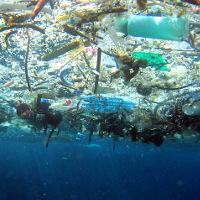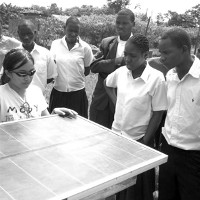
News |
- Manitoba Minnesota Transmission EIS Released
- Peat Mining Ban Lifted In Manitoba
- Clean Drinking Water In Canadian Cities?
- Manitoba Hydro Selects US Transmission Route
- Ocean Cleaning System To Launch 2016
- Manitoba Not Ready For Climate Change
- John Kerry Now Arctic Council Chair
- Fossil Fuel Subsidies Fuel Climate Change
- Solar Industry Growing Fast - IRENA Report
- Harper Government Announces More Emission Goals
- Solar's New Promise from Canada
- NDP Sweeps Alberta Election
| Manitoba Minnesota Transmission EIS Released | 3 July 15 |

Minnesota Power is proposing to build an approximately 220-mile long, 500 kilovolt (kV) transmission line that would cross the international border in Roseau County, and would connect to the intended Manitoba transmission line project based on Manitoba Hydro's preferred route. In Manitoba a scoping document to frame the EIS contents was released in mid 2014. The final preferred route for the transmission line, which is intended for export of Manitoba Hydro energy, was announced after three rounds of public engagement. The Manitoba EIS, to be released in late summer 2015, will need to match contents with the recent licences issued for significant transmission projects in Manitoba. As an international project, and with the recent precedents of Clean Environment Commission hearings for the Bipole III transmission project, Manitoba's cabinet will issue a formal reference to the CEC in fall 2015. Manitoba's Environment Act requires these steps. Two other sets of transmission were included in the mandate for recent CEC hearings.
View June 26, 2015 Minnesota Power news release |
|
 Print version Print version |
Top |
| Peat Mining Ban Lifted In Manitoba | 3 July 15 |

"There is only one way to keep Manitoba peat from accelerating climate change: leave the peat in the ground," provincial Wilderness Committee campaign director Eric Reder said in a statement. According to The Wilderness Committee, Manitoba's peat lands are the province's best natural defence against global warming, as the peat absorbs significant amounts of climate-changing carbon. When those lands are bulldozed, drained and harvested, the stored carbon is released into the atmosphere. “Peat land bogs take thousands of years to form and store vast quantities of carbon. Mining these peat bogs releases all of that stored carbon,” says David Nickarz, Green Party of Manitoba advocate for Conservation and Water Stewardship. “This is a step in the wrong direction.” Globally, peatlands are the world’s most important terrestrial carbon sink, making them one of the greatest climate change mitigation tools available. Peat mining releases this vast carbon store into the air and stops the area from sequestering new carbon. Peat mining further affects local water quality, and removes a distinct ecosystem that houses many unique species. Industry claims that, peat bogs will be restored to their natural state. Peat bogs are often reclaimed into a type of wetland or agricultural land which, while better than nothing, is of lower ecological quality than the original bog. Reclamation also cannot undo the loss of the carbon stored in the original bog. Despite new legislation and Peat Strategy, the required public registry is not in place.
View June 30, 2015 The Green Party of Manitoba article |
|
 Print version Print version |
Top |
| Clean Drinking Water In Canadian Cities? | 3 July 15 |

In Canada, it is left to each province to decide how many tests each of its municipalities should do - a system Health Canada said makes sense based on which contaminants are relevant in any particular region. "They should be testing for everything, maybe not all the time, but at least on a periodic basis, rather than never testing for them at all," said Eva Pip, a University of Winnipeg professor specializing in water quality and toxicology. CBC asked 18 cities in every province and territory to provide a list of the health-related contaminants they test in their water supplies. Only one — Ottawa — tests for all 75 substances found in Health Canada's published guidelines for Canadian drinking water. Some cities, like Calgary, Edmonton and Halifax, test for all but one of the substances in the guidelines. Quebec City tests for 62, Regina 52, Winnipeg 49, St.John's 26 and Iqaluit just tests for 20.
View June 19, 2015 CBC News article |
|
 Print version Print version |
Top |
| Manitoba Hydro Selects US Transmission Route | 30 May 15 |

The Manitoba Minnesota Transmission Project (MMTP) would start at Dorsey Station west of Winnipeg, move along lines through the south side of Winnipeg, connect at the Louis Riel Station east of Winnipeg, and travel south east of the Red River and Highway 59 to Minnesota. The MMTP connects to a similar transmission project in Minnesota. The region of Manitoba this new transmission line would cross includes several towns, primary and secondary highways, farmland, public lands, and private lands. The selected route will use some existing rights of way, but also crosses a lot of private land. Several First Nations are affected by the transmission project, due to constitutional and treaty rights, for both current and historical land uses in the region. Treaty land entitlement options are also relevant in the region. Aboriginal consultations with affected communities are also required, and could start as soon as fall 2015.
View Public Registry File for Manitoba Minnesota Transmission Project |
|
 Print version Print version |
Top |
| Ocean Cleaning System To Launch 2016 | 29 May 15 |

Source: NOAA
In 2013, Boyan Slat,founder and CEO of Dutch-registered nonprofit organization The Ocean Cleanup, developed a trash collector which was promised to clean up the world’s oceans. Slat recently announced that this ambitious project is going to be deployed in 2016. The system will span 2000 meters, becoming the longest floating structure ever deployed in the ocean (beating the current record of 1000 m held by the Tokyo Mega-Float). It will be operational for at least two years, catching plastic pollution before it reaches the shores of the deployment location of Tsushima island. Tsushima island is evaluating whether the plastic can be used as an alternative energy source. “Taking care of the ocean garbage problem is one of the largest environmental challenges mankind faces today. Not only will this first cleanup array contribute to cleaner waters and coasts but it is also an essential step towards our goal of cleaning up the Great Pacific Garbage Patch. This deployment will enable us to study the system’s efficiency and durability over time.” said Boyan Slat, founder and CEO of The Ocean Cleanup.
View May 29, 2015 Al Jazeera America article |
|
 Print version Print version |
Top |
| Manitoba Not Ready For Climate Change | 29 May 15 |

"You see that there are larger changes to the hydrologic cycle that are causing more frequent flooding, greater storms and causing greater infrastructure damage. We are of the view that this could have serious economic consequences for the province, so our meeting today is about how we deal with those matters," Sandford spoke to the Threatened Infrastructure conference Thursday, May 7th, in Winnipeg, hosted by the Manitoba Capital Region. The 2011 flooding in Manitoba, which damaged homes and displaced hundreds, cost more than $1 Billion to fight, and that does not include massive post-flood damages that are still being tallied. Manitoba needs a plan to mitigate climate change impacts.
View May 7, 2015 CBC News article |
|
 Print version Print version |
Top |
| John Kerry Now Arctic Council Chair | 29 May 15 |

Kerry stressed the consequences of unchecked climate change for people in the Arctic and around the planet. In his address to Arctic nation ministers, members of Congress, and other policymakers, Kerry said that the Arctic “is not just a picturesque landscape. It’s a home. It’s a lifestyle. It has a history.” Arctic communities, he said, are “4 million strong living there for centuries, and believe me, they are an essential part of everything that is critical to the region.” Ministers from eight Arctic states and leaders of Arctic Indigenous Peoples met in Iqaluit, Nunavut, Canada, marking conclusion of Canada’s Arctic Council Chairmanship and the beginning of United States’ Chairmanship. Ministers signed the Iqaluit Declaration 2015, which highlights the accomplishments of the Arctic Council during Canada’s Chairmanship (2013-2015) and guides the work of the Council under the Chairmanship of the United States(2015-2017). As Arctic Council Chairman, Kerry has a rare opportunity to build momentum for a strong outcome in Paris climate negotiations. Kerry has already started to take advantage of this opportuniy, by making climate change a central focus of his Arctic Council chairmanship. He plans to expand access to renewable energy technologies in the Arctic, and press for full implementation of the Framework for Enhanced Action to Reduce Black Carbon and Methane Emissions, adopted at the April 2015 Arctic Council Ministerial meeting in Inqaluit, Canada.
View May 26, 2015 Think Progress article |
|
 Print version Print version |
Top |
| Fossil Fuel Subsidies Fuel Climate Change | 22 May 15 |

The IMF calls the revelation “shocking” and says the figure is an “extremely robust” estimate of the true cost of fossil fuels. The $5.3tn subsidy estimated for 2015 is greater than the total health spending of all the world’s governments. This $5.3 trillion is also contributing to millions of deaths, heart attacks, asthma cases, and other health effects of local air pollution in the United States and countries around the world. Nicholas Stern, an eminent climate economist at the London School of Economics, said: “This very important analysis shatters the myth that fossil fuels are cheap by showing just how huge their real costs are. There is no justification for these enormous subsidies for fossil fuels, which distort markets and damages economies, particularly in poorer countries.” “These [fossil fuel subsidy] estimates are shocking,” said Vitor Gaspar, the IMF’s head of fiscal affairs and former finance minister of Portugal. “Energy prices remain woefully below levels that reflect their true costs.”
View May 21, 2015 The Guardian article |
|
 Print version Print version |
Top |
| Solar Industry Growing Fast - IRENA Report | 22 May 15 |

Rising demand for energy, together with the cost of replacing the country’s aging generation facilities, gives Canada the opportunity to push forward with renewable energy to help create a stronger, more diversified and modern energy system. The sun’s ability to generate energy when it’s needed most (and when it is most expensive) – during the day – is what makes solar energy unique and attractive. Solar energy reduces reliance on expensive conventional sources of energy to meet peak demand, but also the need to maintain and carry costs of backup power like natural gas “peaking” plants. Additional cost savings are realized because solar energy is consumed where it is produced – individual buildings can generate heat or electricity from a rooftop or wall-mounted application. Canadian solar resource is world-class. Much of Canada has superior solar resources to Germany, the global leader in solar technology, an indication of the phenomenal potential of the solar industry in Canada.
View Solar Energy Industries Association research |
|
 Print version Print version |
Top |
| Harper Government Announces More Emission Goals | 22 May 15 |

The 2030 emissions target was submitted to the United Nations as part of preparations for a UN Climate summit to be held in Paris in December where nations aim to conclude a new binding global climate agreement to avert the worst impact of global warming. “A target consistent with the scientific consensus would see Canada commit to cutting carbon pollution nationally by at least one third by 2025 (35% below 2005) combined with $4 billion annually in international climate finance by 2020 that would aim to generate global reductions equivalent to Canada’s remaining greenhouse gas emissions, ” says Steven Guilbault, Equiterre. ‘Over the last few years our federal government has made various climate change commitments – while Canada’s emissions keep increasing. Action is overdue,’ commented Gaile Whelan-Enns, Manitoba Wildlands Director and Climate Action Network Board member.
View May 15, 2015 Pembina Institute article |
|
 Print version Print version |
Top |
| Solar's New Promise from Canada | 8 May 15 |

Source: Broadbent Institute
As Full got into engineering as a teen, she noticed the influence of the oil and gas industry. A high-school trip to the Arctic – a "visceral, physical" experience where she saw climate change harming polar bears first-hand – sealed her commitment. The result is the SunSaluter, a low-cost device that makes solar panels track the movement of the sun using water bottles and gravity. The SunSaluter increases energy output by 40 per cent while producing clean water. The device uses water-filled bottles that drip through a filter, becoming lighter, and causes the solar panel to adjust its angle, tracking the sun during the course of a day. The SunSaluter aims to increase energy and clean drinking water accessibility to off-grid communities, and thus mitigate environmental and health implications from traditional energy and water sources. The SunSaluter has won the Westly Prize, the Mashable-UN Foundation Startups for Social Good Challenge, second prize at the Postcode Lottery Green Challenge, and the grand prize at the Staples-Ashoka Youth Social Entrepreneurship Challenge.
Visit Sunsaluter website |
|
 Print version Print version |
Top |
| NDP Sweeps Alberta Election | 8 May 15 |

Source: Broadbent Institute
Under an NDP government, resource extraction will be based on scientific research rather than “the outcome of a lobbyist meeting on a golf course somewhere,” Notley told reporters during the campaign. This NDP election victory in Alberta is a shake-up with ramifications across the country, Notley is committed to tougher provincial action against climate change and a new approach to pipeline mega-projects. “For the first time, we’re thinking seriously about how Alberta can be part of the climate solution,” said Keith Stewart, head energy campaigner for Greenpeace Canada. It’s one of many groups that opposed new pipelines from Alberta on the grounds that expanded oil sands production will add to the greenhouse gas emissions linked to global warming. “With this election, Albertans have voted for change — and that change includes improving Alberta’s environmental record and its approach to climate change.” Ed Whittingham, executive director of the Pembina Institute, stated in response to the outcome of the Alberta election.
View May 6, 2015 CBC News article |
|
 Print version Print version |
Top |


 RSS Feeds:
RSS Feeds: